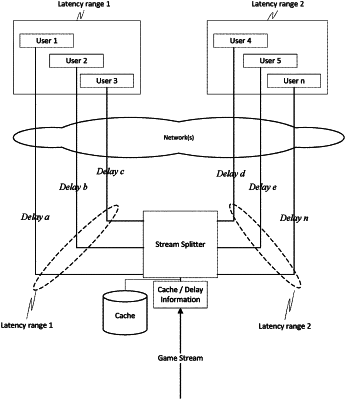| CPC A63F 13/358 (2014.09) [A63F 13/216 (2014.09); A63F 13/65 (2014.09); H04L 7/0041 (2013.01); H04L 43/08 (2013.01); H04L 43/16 (2013.01); H04L 67/131 (2022.05); H04L 69/28 (2013.01)] | 20 Claims |

|
1. A geo-location computer-based game event system that manages latency sensitive user created game events, the system comprising:
at least one non-transitory computer readable memory storing software instructions and storing a notarized ledger; and
at least one processor coupled with the at least one memory and configured to execute the software instructions to perform at least the following operations:
measuring endpoint latencies to one or more user endpoints over a network;
grouping the one or more user endpoints into at least two groups based on the endpoint latencies, wherein a first group of the at least two groups has a first common latency range and a second group of the at least two groups has a second, different common latency range;
storing, in the at least one memory, the first common latency range and the second common latency range, information associated with the at least two groups, and information associated with the one or more user endpoints;
receiving at least one user created game event and storing the at least one user created game event in the notarized ledger;
determining a required presentation time of the at least one user created game event based on the stored first common latency range and based on the second common latency range, and storing the required presentation time in the notarized ledger;
determining at least one delay of the at least one user created game event to be sent to the one or more user endpoints based at least on the required presentation time and on the endpoint latencies;
generating a non-latency sensitive event for a high latency group selected from the at least two groups based on the at least one delay and the first common latency range and the second common latency range;
sending, while accounting for the at least one delay, the at least one user created game event and the required presentation time to the one or more user endpoints in the at least two groups; and
enabling presentation of the at least one user created game event and the non-latency sensitive event on the at least two groups at the required presentation time.
|